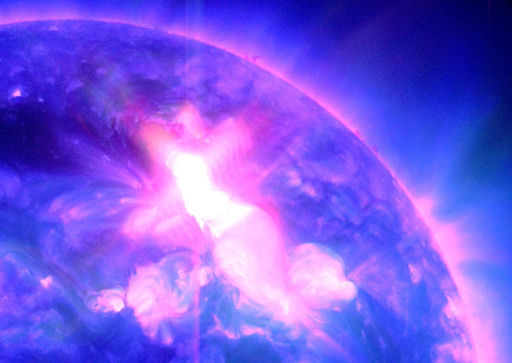CME IMPACT: As expected, a CME hit Earth's magnetic field on Jan. 24th at approximately 1500 UT (10 am EST). Geomagnetic storms are likely in the hours ahead. If it's dark where you live, be alert for auroras. Magnetic storm alerts: text, voice.
RADIATION STORM IN PROGRESS: Solar protons accelerated by this morning's M9-class solar flare are streaming past Earth. On the NOAA scale of radiation storms, this one ranks S3, which means it could, e.g., cause isolated reboots of computers onboard Earth-orbiting satellites and interfere with polar radio communications. An example of satellite effects: The "snow" in this SOHO coronagraph movie is caused by protons hitting the observatory's onboard camera.
ALMOST-X FLARE AND CME (UPDATED): On Jan. 23rd around 0359 UT, big sunspot 1402 erupted, producing a long-duration M9-class solar flare. The explosion's M9-ranking puts it on the threshold of being an X-flare, the most powerful kind. NASA's Solar Dynamics Observatory captured the flare's extreme ultraviolet flash:
The Solar and Heliospheric Observatory (SOHO) and NASA's STEREO-B spacecraft detected a CME rapidly emerging from the blast site: movie. Analysts at the Goddard Space Weather Lab say the leading edge of the CME will reach Earth on Jan. 24 at 14:18UT (+/- 7 hours). Their animated forecast track shows that Mars is in the line of fire, too; the CME will hit the Red Planet during the late hours of Jan. 25.
This is a relatively substantial and fast-moving (2200 km/s) CME. Spacecraft in geosynchronous, polar and other orbits passing through Earth's ring current and auroral regions could be affected by the cloud's arrival. In addition, strong geomagnetic storms are possible, so high-latitude sky watchers should be alert for auroras. Magnetic storm alerts: text, voice.

![]()
Solar wind
speed: 293.3 km/sec
density: 2.7 protons/cm3
explanation | more data
Updated: Today at 1547 UT
![]()
X-ray Solar Flares
6-hr max: C2 0953 UT Jan24
24-hr: C2 0953 UT Jan24
explanation | more data
Updated: Today at: 1500 UT
![]()
![]()
![]()
Daily Sun: 24 Jan 12
![]()
![]()
Sunspots 1401 and 1402 pose a threat for M-class solar flares. Credit: SDO/HMI
![]()
![]()
![]()
Sunspot number: 108
What is the sunspot number?
Updated 22 Jan 2012
Spotless Days
Current Stretch: 0 days
2012 total: 0 days (0%)
2011 total: 2 days (<1%)
2010 total: 51 days (14%)
2009 total: 260 days (71%)
Since 2004: 821 days
Typical Solar Min: 486 days
Updated 22 Jan 2012
The Radio Sun
10.7 cm flux: 141 sfu
explanation | more data
Updated 22 Jan 2012
![]()
![]()
![]()
Current Auroral Oval:
![]()
Switch to: Europe, USA, New Zealand, Antarctica
Credit: NOAA/POES
![]()
![]()
![]()
Planetary K-index
Now: Kp= 1 quiet
24-hr max: Kp= 3 quiet
explanation | more data
![]()
Interplanetary Mag. Field
Btotal: 13.5 nT
Bz: 10.0 nT north
explanation | more data
Updated: Today at 1546 UT
![]()
![]()
![]()
Coronal Holes: 23 Jan 12
![]()
![]()
Solar wind flowing from the indicated coronal hole should reach Earth on Jan. 27-28. Credit: SDO/AIA.





